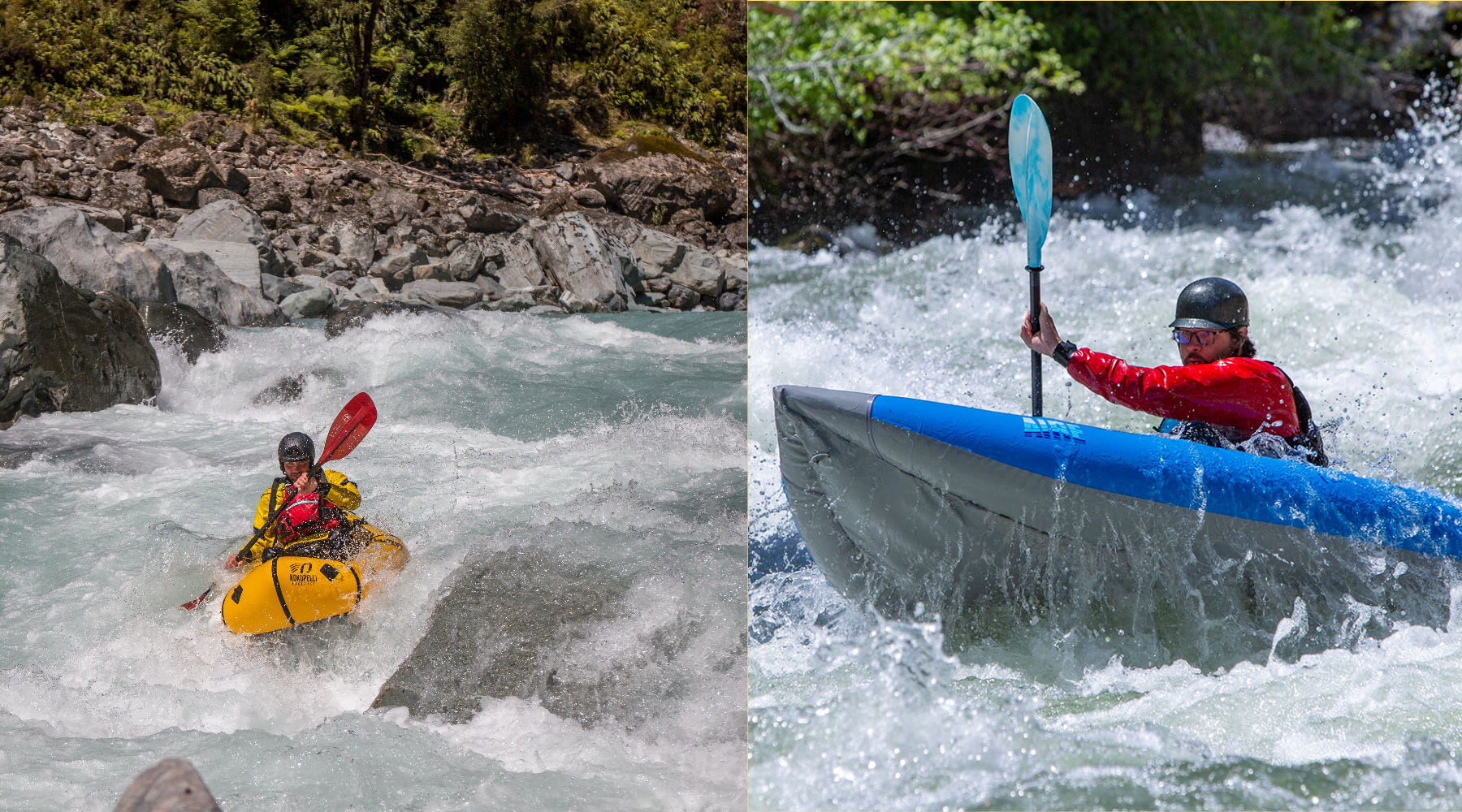Inflatable Kayaks and Packrafts are often confused with each other. Our gear experts have broken down the similarities and differences between inflatable kayaks and packrafts that can help you decide which vessel is right for you.
Purpose
Inflatable kayaks are often treated as mini-rafts. They are great additions for multi-day trips and easy cruises since they allow for a variety of paddlers to hop in and out of them with ease.
Packrafts are great on expedition trips where there is the potential (or actuality) of hiking and floating. Packrafts are perfect for these adventures thanks to their light weight and gear hauling capabilities.
Weight
Inflatable kayaks are significantly heavier than packrafts. For example, an AIRE Lynx IK weighs about 33 pounds compared to Kokopelli's packrafts, which on average weigh between 6 and 19 pounds.
Kokopelli offers two materials that impact the overall packraft weight:
- Thermoplastic Polyurethane (TPU) - Packrafts made from TPU are extremely light and can pack down almost as small as a Nalgene water bottle.
- Polyvinyl Chloride (PVC) - A heavier plastic that most paddlers are familiar with (the majority of whitewater rafts are constructed using PVC).
Size
Kokopelli's packrafts are smaller when inflated, and pack down much smaller, than a traditional inflatable kayak. For reference, the Kokopelli XPD packs down to roughly 24" x 10" while an AIRE Tributary Spud, one of the smallest PVC IKs on the market, packs down to about 24" x 20" when tightly rolled.
Durability
Inflatable kayaks are heavier than packrafts – not only because they are larger, but because they are constructed with PVC which is an ultra-durable material.
The IKs we carry at CKS are constructed with PVC and are known for being high-quality, ultra-tough duckies that can hold up to any abuse thrown their way. Because they are made from the same materials, Kokopelli's PVC Packrafts are regarded to be just as durable as the other PVC inflatables we stock.
 |
 |
PVC Inflatable Kayaks |
PVC Packrafts |
Kokopelli's TPU packrafts are less durable and abrasion-resistant compared to inflatables made out of PVC or Hypalon, but are significantly lighter and more packable.
On the whole, you could argue that inflatable kayaks are more durable than packrafts, unless you are purchasing a PVC packraft. The benefit of a PVC packraft over a PVC inflatable kayak is that you are getting just about the same durability in a much smaller package.
Portability
If you are considering a long hike in to your paddle, we recommend choosing a packraft over an inflatable kayak. The TPU packrafts from Kokopelli are ultra-portable and make the most sense for those looking for more wild, off-grid adventures.

If you are considering paddling something like Brown's Canyon on the Arkansas River in Colorado, where you are starting at the designated put-in and ending at the constructed take-out, with little to no portaging, you might value a more durable inflatable kayak that is designed for whitewater use.
Gear Hauling
Both inflatable kayaks and packrafts come stock with D-rings that allow you to use cam straps to attach waterproof dry bags to the deck. If you are going on an overnight trip, taking an inflatable kayak will likely be your better bet since they have higher weight capacities and more room to sprawl out even when loaded down.
Self-Bailing
Self-bailing means an inflatable has holes along the floor of the vessel to drain water, as shown below.

All inflatable kayaks sold at CKS Online are self-bailing, however, we do not currently carry a self-bailing packraft. If you are going to paddling whitewater at all, we highly recommend that a self-bailing craft.
Kokopelli's "bucket boats," like the XPD and Twain models, have sealed floors and are best for flatwater paddling.
Speed
Inflatable kayaks are longer than packrafts, and this longer waterline often makes them faster than most packrafts.
Comfort
The length and shape of inflatable kayaks allow you the freedom to stretch your legs out, sit cross-legged or even straddle the tube or sit on your knees. This is a freedom that's not awarded with a packraft.

Upgrades + Accessories
All of Kokopelli's PVC packrafts come with a floor pump called a Nanopump. All TPU packrafts come with an inflation bag.
Each packraft also comes with compression straps, which can be thrown around the boat to wrap it up small and tightly for transport or storage.
All Kokopelli packrafts also come with a seat floor back band that can store a small accessory like a phone and an inflatable repair kit.
 |
Included Kokopelli Packraft Accessories |
Kokopelli packrafts do not come with paddles. If you're considering river paddling, we recommend you purchase a durable, whitewater-grade paddle from Aquabound or Werner.
Inflatable kayaks do not come with pumps or paddles, but they do come with the appropriate amounts of inflatable seats and repair kits.
Cost
Obviously, cost plays a huge factor in any major gear purchase.
Kokopelli PVC packrafts are significantly less expensive than most of our Inflatable Kayak offerings, with the exception of the AIRE Spud, which only costs $539.
The Kokopelli TPU Packrafts can get expensive, upwards of $1500, making them more comparable to the price point of inflatable kayaks.
Why Get a Packraft Over an IK?
One word: convenience.Pack is in the name, and they quite literally pack very small. With packrafts, the biggest advantage is the small size and light weight. Both packrafts and inflatable kayaks perform extremely well on the water.
At the end of the day, inflatable kayaks and packrafts are similar crafts and we doubt you'd be unhappy with either choice, but understand that they are different boats best suited for different purposes.



